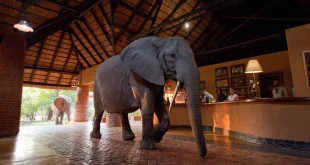The Everest Base Camp Trek is a popular trekking route in the Solu-Khumbu region of Nepal. It offers stunning views of some of the world’s highest peaks, including Mount Everest, and provides an opportunity for trekkers to experience the unique culture and way of life of the Sherpa people. The trek is approximately 140 miles round trip and takes about 12 to 14 days to complete.
The Everest Base Camp trek starts in Lukla, a small town located at an altitude of 2,804 meters (9,199 feet). From Lukla, trekkers follow the Dudh Koshi River, passing through several villages and forests, to reach Namche Bazaar, the largest town in the Solu-Khumbu region. Namche Bazaar is an important rest and acclimatization stop on the trek, as it is located at an altitude of 3,440 meters (11,286 feet).
From Namche Bazaar, trekkers continue along the trail, passing through several more villages and passing Tengboche Monastery, which is the largest Buddhist monastery in the Solu-Khumbu region. The trail then ascends to Dingboche, at an altitude of 4,410 meters (14,468 feet), where trekkers can take another rest day to acclimatize to the altitude.
From Dingboche, the trail continues to ascend to Gorak Shep, located at an altitude of 5,160 meters (16,929 feet). From Gorak Shep, trekkers can visit the base camp of Mount Everest, which is located at an altitude of 5,364 meters (17,598 feet). The hike to the base camp is a strenuous one and requires a good level of physical fitness, but the views of the surrounding peaks and glaciers are truly breathtaking.
How to Prepare for Everest Base Camp Trek?
- Get in shape physically with cardio and strength training.
- Acclimatize to high altitude by gradually increasing elevation.
- Pack appropriate gear, including clothing, footwear, and gear.
- Obtain necessary permits and visas before leaving.
- Consider altitude sickness and preventative measures.
- Research and be aware of local customs and culture.
- Pack enough food and water for the trek.
- Hire a reputable guide or join a trekking group.
- Stay informed on current conditions and weather.
- Mentally prepare for the physical and mental challenges.
Best season for Everest Base Camp Trek
The best season for the 12 Days Everest Base Camp Trek is from September to November and from March to May. During these months, the weather is stable, with clear skies and mild temperatures, making for the best trekking conditions. In the monsoon season (June to August), the trail can be wet and slippery, and visibility can be limited. During the winter months (December to February), temperatures can be extremely cold and snowfall can make the trail difficult to navigate.
How to Book Everest Base Camp Trek package
To book an Everest Base Camp Trek package, you can follow these steps:
- Research trekking companies and choose a reputable one.
- Check the company’s website or contact them directly for package options and pricing.
- Read reviews and ask for recommendations from other trekkers.
- Decide on the type of package that best fits your needs, such as group or private, standard or luxury.
- Confirm the itinerary, inclusions, and exclusions with the company.
- Provide personal information, such as passport details and emergency contact information.
- Make a payment for the trek package, either through the company’s website or by bank transfer.
- Receive confirmation of your booking and check for any additional information or instructions.
- Prepare for the trek, including obtaining necessary permits, visas, and vaccinations.
- Enjoy your adventure in the majestic Himalayas!
What is required things for Everest Trek?
Here is a list of essential items to bring on the Everest Base Camp Trek:
- Warm and waterproof clothing, including a down jacket
- Hiking boots and socks
- Sleeping bag and pad
- Headlamp and extra batteries
- Sunscreen and sunglasses
- First aid kit and necessary medications
- Water bottle and purification system
- Backpack with rain cover
- Trekking poles
- Snacks and energy bars
- Cash, credit card, and necessary documents (passport, visas, etc.)
- Portable charger and camera
- Personal hygiene items and toiletries
- Trash bags for carrying out waste.
It’s recommended to check with your trekking company for a complete and specific gear list for the trek.
 Business To Many My WordPress Blog
Business To Many My WordPress Blog



